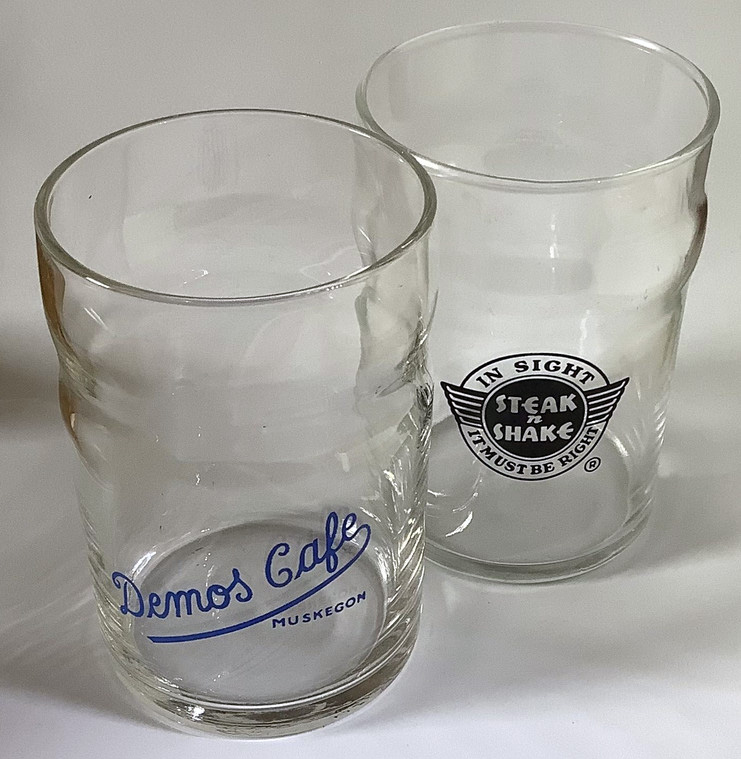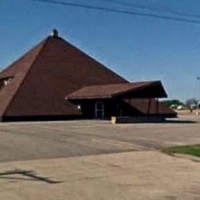Fine table settings were not to be taken for granted in pre-Civil War American eating places. In 1843 an English visitor was delighted to find a Charleston hotel with “clean table cloths and silver forks.” He recommended the Jones Hotel, run by a Black proprietor named Jehu Jones, the son of a freed slave. Thick dishes, often chipped, and crude forks were more typical of many hotels then.
According to Junius Henri Browne’s The Great Metropolis, in 1869 there were many restaurants in New York City but only in the most expensive, such as Delmonico’s, did the diner find “silver, and porcelain, and crystal, and fine linen.” Common basement eateries, on the other hand, had “broken earthen-ware, soiled table-cloths, and coarse dishes.”
Coarse dishes had become the definitive sign of a cheap restaurant. But in the later 19th century, when early fast-food chains began to form, they attempted to break the equation that thick dishes and bowls indicated filth by being insistent about cleanliness. They stuck with thick dishes that didn’t break or chip simply because they were more practical.
Founded in the late 1880s, Baltimore Dairy Lunch was an early challenger to the old assumptions about thick chinaware. The first unit was opened in Baltimore by a postal clerk. By 1920 there were about 140 locations in large cities through much of the Northeastern U.S. Menus were simple and prices were low. Customers went to a counter to get their food, and consumed it quickly, either while standing at a high counter-type table or sitting in a one-arm chair similar to a school desk. This thick, shallow bowl – possibly used for milk toast – expresses the spartan simplicity of Baltimore Lunches. Despite some yellowing along the edges, it has held up well over the decades.
Ontra Cafeteria
The Ontra (pronounced “on tray”) was a cafeteria begun as a working women’s lunch club, one of four operated by Mary Dutton in Chicago in the 1910s. Like the Baltimore Dairy Lunches they were meant to be affordable and appealed to those who did not want to spend much for a noonday meal. Undoubtedly, like most women cafeteria owners who had studied home economics, Mary Dutton put a high stock on practicality and thrift. This Ontra plate, date unknown, is sturdy but not as thick as dairy lunch dishware.
These sturdy glasses are typical of mid-century restaurant glassware with their non-chip rims and their dents and bulges that make them slip proof as well. It’s likely they were produced by Libbey, a major advertiser of glassware in mid-century restaurant trade journals. An advertisement assured restaurant buyers that “Libbey Safedge glassware offers you a wide selection of patterns in all sizes, for beverage and bar service. And because of its durability, you are assured of economy in operation . . . with every glass backed by the famous Libbey guarantee: ‘A new glass if the rim of a Libbey ‘Safedge’ glass ever chips.’”
The Woolworth plate came from my local dime store when it was closing for good in 1990. Its pattern is one of the endless variations on a theme of this sort, one that could appear in any of a number of colors. Again, a sturdy plate for customers who never gave it a second look.
Cheap dishes, glasses, and flatware simply wouldn’t do for upscale restaurants. The better-off classes demanded finer table settings. This had always been true for the wealthy, but in the early 20th century, the middle-class also raised its expectations.
Good taste expressed in restrained design suggestive of nature was the motto of The Craftsman in New York City from 1913 to 1916. Lunch and dinnerware was Onondaga white china with a light brown pinecone design forming a border. For afternoon tea, Lenox furnished an off-white china featuring the Stickley “Als Ik Kan” symbol and motto that promised integrity of method and materials.
Alice Foote MacDougall coffee shops
Women’s tea shops tended to stress individuality. This meant rejecting standardized restaurant ware, instead establishing a unique identity with decor and tableware. Alice Foote MacDougall — who called her tea shops coffee shops to attract men — complained loudly about thick cups and dishes. In her 1929 book, The Secret of Successful Restaurants, she described how, formerly, she had to eat in restaurants “where china, white, thick, and hideous was used.” In them, food was served “naked on a bold, pitiless plate half an inch thick and consumptive in its whiteness . . .” By contrast, she said, the plates in her restaurants were colorful with shades of yellow, blue, turquoise, and lilac.
Shown above is the Graziella pattern used in her Italian-themed coffee shops. Like all the imported china in her restaurants it was also for sale ($2.50 for a dinner plate or a cup and saucer).
The Four Seasons
In 1966 a well-known restaurant consultant explained how people with good incomes preferred to dine when they went out. They liked fine restaurants, appreciated good food, and ate out often. “They expect the restaurant decor to be as nice as the decor in their own homes!,” he explained, adding, “They like fine china.”
Given that The Four Seasons was a power-lunch site, I’m sure there were some guests who paid absolutely no attention to the fine design of the hundred items designed by Garth and Ada Huxtable, nor did they notice that unlike the glasses used in dime stores and lunch counters, their wine glass had no reinforced edges. Others guests no doubt were pleased with the elegant simplicity of the designs.
When the restaurant closed and the furnishings and serving pieces were auctioned in 2018, bidders paid goodly sums for items such as the bread servers (as much as $6,250) and cream and sugar sets (more than $2,000) shown above. I do find it humorous that the cream and sugar set included so plebeian an object as a container for packets of sugar substitutes.
Today, collectors of restaurant ware value a wide range of china, including the thick kind often bearing the logo of a once-popular eating place.
© Jan Whitaker, 2022



















 It's great to hear from readers and I take time to answer queries. I can't always find what you are looking for, but I do appreciate getting thank yous no matter what the outcome.
It's great to hear from readers and I take time to answer queries. I can't always find what you are looking for, but I do appreciate getting thank yous no matter what the outcome.



As an amateur dinerware collector, I appreciated this! My best find so far was a huge box of dirty cups, saucers, and plates at a thrift store. When I asked what they wanted for it, they gave it to me…free!
Everything cleaned up just fine.
Nice article. We have a restaurant here with locally handmade dishes. m
________________________________
Happy New Year Jan! Love this post! Restaurant ware is such a great storyteller. I have discovered more interesting fun facts about American culture from a simple dish than I ever would have anticipated. And love your Baltimore Dairy, how cute! Thanks for sharing.
Thank you and happy new year!
My sister used to pick up vintage restaurant ware at flea markets and tag sales. She had an amazing collection that she used every day!
Friends:
As some of you may know, I am America’s senior collector of Florida East Coast Railway, Florida transportation memorabilia, Miami memorabilia and Floridiana, and how, you ask, is that relevant to this discussion, and, in response, I thank you and tell you that I am glad you asked.
As America’s senior collector in those four categories (this coming May starts my 64th year of collecting all this junque), we have, here in The Bramson Archive, some of the most stunning Florida hotel and restaurant china that exists and items such as service plates, large footed compotes and many more stunningly beautiful pieces are part of the collection.
In addition, though, and besides FEC and other Florida railroads, we have collected, for all of that time, all U S railroad and trolley memorabilia, and in the process The Bramson Archive is now the repository for literally hundreds of pieces of dining and lounge car china, silver and glassware, as well as ancillary items such as flatware, holloware, menus, napkins and many more dining car related items. If you are ever going to be in South Florida, please let us know OFF LIST at sbramson@bellsouth.net and we will be pleased to have you visit the museum in order that you may see all this great stuff.
And for those of you who are interested, our newest book is LOST RESTAURANTS of MIAMI and it is really a wonderful look at Greater Miami’s grand dining spots of the past, everything from the beloved hamburger chain Royal Castle to the delis, full service restaurants, cafeterias and more.
Be well, all, and please stay safe. Above all, have a grand 2022.
Cordially,
Seth
And if you are ever in the Houston area, the Galveston Railroad Museum has quite a collection of Railroad china as well.
I’m of two minds to confess this, because I wouldn’t trade them for anything, but my husband and I used to “liberate” the creamers when we ate out and amassed quite a collection before we A) realized it was stealing and B) restaurants switched to disposable paper cups. We have some fine dining beauties, but my favorite is probably Simple Simon and the Pie Man from Howard Johnson’s.
When it comes to fine dining how far we have come… Or have we?
Was “Ontra” supposed to sound like entree?
We have a few bits of restaurant ware, including those ubiquitous Ricard water pitchers.
It was supposed to sound like “On [the] tray”. Corny? I like those pitchers.
Love historic restaurant ware and have been collecting it for years. I have many examples from fancy to plain, including LOUIS SHERRY’S, DELMONICO’S (46th St), HOTELS ASTOR and MARTINIQUE, LUNDY’S (Brooklyn), THE BRASS RAIL, SCHRAFFT’S, H & H AUTOMAT, WALGREENS, WOOLWORTHS and WHITE CASTLE!
Here in Malaysia, thick glass or stoneware plates are the mark of a middle class restaurant. Inexpensive restaurants generally use plastic plates, banana leaf, or waxed paper. More expensive restaurants tend to use thinner, finer tableware. Certain recipes benefit from being wrapped in, and served on, banana leaf. An interesting case in which tableware directly affects the flavour of the food .
Interesting, thanks for pointing out how tableware can be part of the flavor! As for here, I didn’t really catch up to today, when the “dishware” might well be plastic or paper, or just a bag or box. Aesthetically, a banana leaf would be a step up in many cases.
This discussion of the evolution of tableware in restaurants is truly enlightening. It helps us understand more about the dining out experience.
Smashing! Thank you Jan Whitaker for your enlightened histories. You bring the table alive. Kudos. HAPPY NEW YEAR.
Happy New Year to you too!
Love that heavy, clunky diner-ware, actually. But I always feel really special when a fine restaurant serves water in that paper-thin glassware!